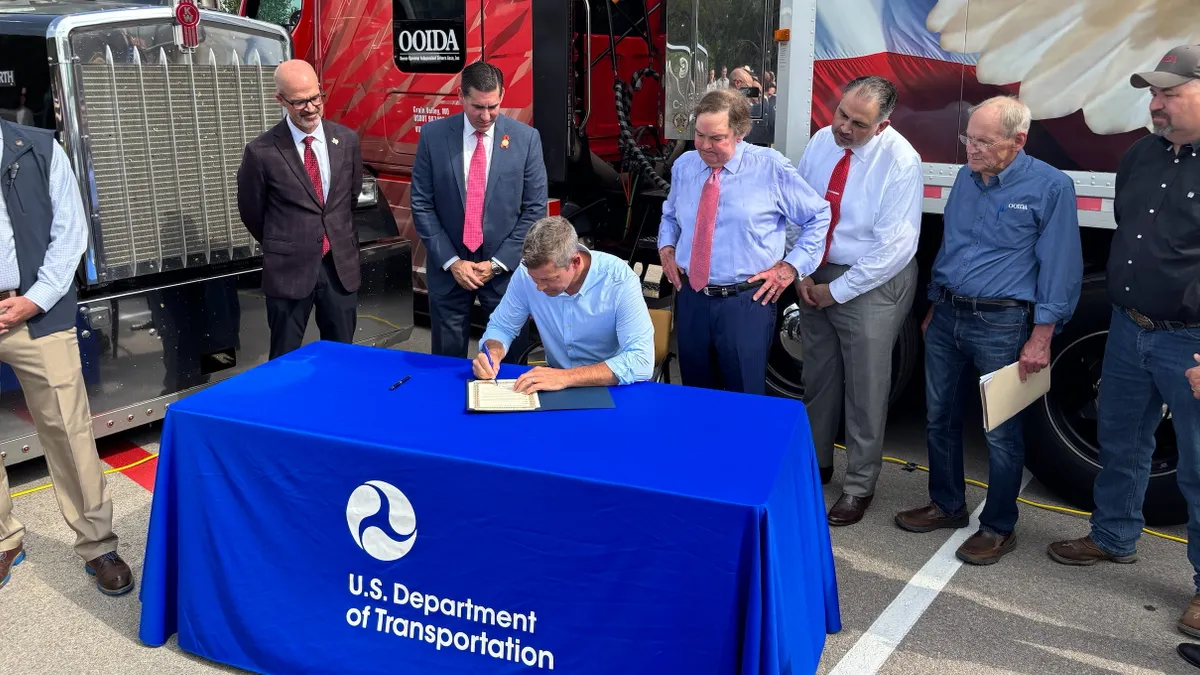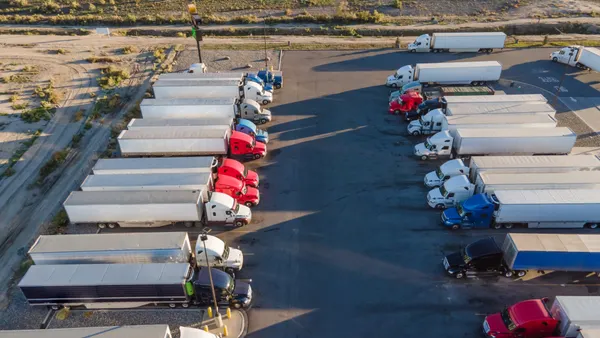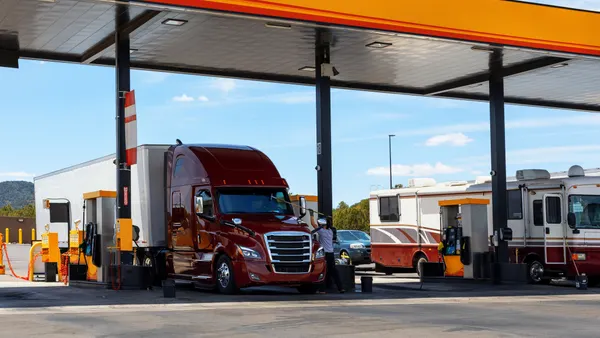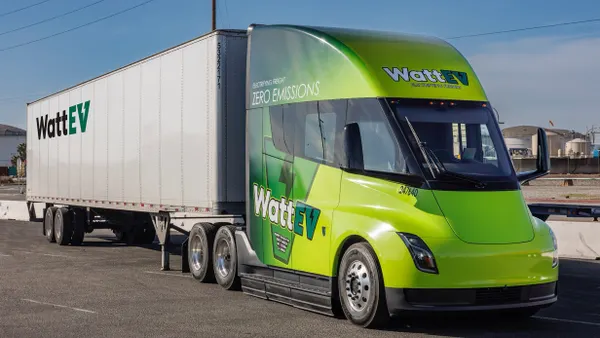This article is part of a series about how six big fleets are planning for a hot freight market in 2022. Click here to view the entire package.
The trucking market is hot. Fleets have been setting various company records when reporting earnings, and rates are inflationary.
"The market conditions that impact Ryder right now are pretty good, both from a freight-demand perspective and customer demand," Ryder System CFO John Diez said during the Stephens Annual Investment Conference last December.
Add to that favorable used-equipment prices, and it paints a rosy picture for Ryder.
But tailwinds are rarely permanent. Identifying opportunities for operational improvements during booms is just as important as spotting them during busts.
Diez spoke about five key trends Ryder is keeping tabs on, and how the company is poised — or plans — to get ahead.
1. Compensation and benefits are top of mind
The American Trucking Associations said the industry is down some 80,000 drivers. Labor headwinds are bumping up prices across the supply chain.
"We're going back to customers looking for price increases to really keep up with the wage inflation we're seeing in that space. We've made good progress on that side. And then I think the market conditions are going to improve," Diez said.
A large portion of Ryder's dedicated operations are for specialized delivery, be it bricks, steel or another material that requires knowledge beyond driving dock to dock. That also means wages have "probably escalated quicker" for specialized drivers than OTR drivers, Diez said.
"With that, the driver space becomes much more challenging. So, we're constantly looking to get ahead of the turnover," he said.
Getting ahead means making sure driving jobs at Ryder are attractive. Going forward, the company will continue to examine wage increases and improvements to benefits packages, Diez said.
Fleets across the board are using benefits as a recruitment and retention tool. For example, some have begun offering immediate medical coverage, eliminating any waiting period.
2. Dedicated is poised to keep booming
If there is a bright side to driver constraints, it might be that such struggles are prompting shippers to lean more on their trucking partners to supply transport services, rather than their private fleets.
"That's really helped that business deliver some great sales results. We're gonna expect that tailwind and that secular trend of driver challenges to continue to promote tailwind for our dedicated business," Diez said.
Ryder's fleet management segment has reaped some of the benefit from that phenomenon. Many shippers don't specialize in transportation, so they're turning to Ryder to find drivers and execute on logistics.
"The health of the [dedicated] pipeline is probably better than we've seen in the past."

John Diez
CFO, Ryder System
Dedicated posted double-digit growth in Q3, which he expected to carry over to Q4. In 2022 Ryder is targeting 8% or 9% growth, though Diez said he thinks its going to surpass that.
"What we're seeing is the pipeline strengthen, based on private fleets. So, I would say the health of the pipeline is probably better than we've seen in the past," Diez said.
Ryder isn't the only one spotting this trend. It's one of the reasons Schneider spent $263 million to acquire a dedicated company.
3. A shift toward lighter trucks in lease and rental
When dedicated is booming at Ryder, that takes equipment away from ChoiceLease. Though the company has posted "two great sales years back to back," Diez said, there hasn't been visible growth in its fleet. Delivery windows for equipment have elongated. So when a truck leaves the fleet, it is not necessarily being replaced.
That will likely change in the second half of 2022 into 2023, he said. The full-year 2022 outlook doesn't project significant growth. That means Ryder is being even more selective in which customers it takes on.
In its commercial rental business, Ryder has noticed a shift toward lighter trucks.
"With e-commerce, we're seeing just the demand there go through the roof for light-duty and medium-duty trucks, straight trucks as opposed to tractors. So, we think that's a market that could provide stability in that product line for longer," Diez said.
Diez projected the shift to lighter models will continue to grow, and the change will be visible by 2025. The smaller trucks represent about 60% of the power fleet in the commercial rental segment, which includes some trailers, he said. Going forward, the company is looking to grow that to as much as 70%.
Ryder will continue to explore investment opportunities in that space, he said.
4. Used-truck prices to stay up — but not forever
Used-truck prices are up and, according to Diez, are not likely to come down in 2022. To gauge this, Ryder looks at market inventories, he said.
Usually, market inventories are at 60,000. At the end of last year, they were around 30,000. So, for prices to come down, that number would have to rise significantly. With OEMs exercising caution around new Class 8 builds and pushing large portions of production to 2023, it would take a while for that to occur.
"You're looking at low inventory levels that, in the near term, I don't see them moving up quickly enough," he said. "So, we do expect a pretty good pricing environment to push into 2022."
But Ryder knows prices will come down eventually. The company has worked to de-risk the business to prepare for the next downturn, such as taking "just a modest amount of deprecation."
"What we're looking to do is give investors the confidence that they're not going to see losses from used vehicles, that we're gonna continue to deliver gains. They're not going to be at the same level we experienced today," Diez said.
5. Prepping now for truck models of the future
Ryder is working with OEMs, startups and established ones alike to test electric trucks. The company is also active on the autonomous-vehicle front, working with TuSimple, Waymo, Embark, Gatik and others.
Being involved helps ensure the fleet stays ahead of the curve — and has a hand in developing technologies and networks.
Autonomous vehicles
"We think we have a great business model that can be leveraged for autonomous," Diez said.
The company is participating in pilots for operations, such as last-mile delivery, as well as in maintenance roles.
AV components will be highly specialized, he said. If Ryder can properly train its technicians, that could amount to a sizable competitive advantage.
But the success of any future maintenance offerings depends on widespread adoption. The technology is still being proven out and developed, but Ryder views its participating in network design in the early stages as a way to guide it in the right direction.
"It's early," he said of the technology. "What we're looking to do is figure out, how can we create value long-term, whether it's leveraging our real estate, leveraging our capabilities and know-how, or just simply just leveraging our service maintenance capabilities to support that business. That is a big opportunity for us as we look forward."
Electric vehicles
When it comes to heavy-duty electric vehicles, "the economics just don't work and the physics are still under review," Diez said. "So, I think that will be longer term."
Unless, that is, the government gets even more involved. The regulatory environment "can tip the scales," Diez said, whether that's in California or other states.
"We've seen a few states talk about it, but we haven't seen broad momentum around that just yet," he said. "Clearly, on the passenger vehicle side, you're seeing that, and you're seeing the OEMs react to it. We haven't seen that yet, but we're keeping an eye on it."
Light-duty EVs, on the other hand, could be on a shorter timeline. Diez anticipates adoption will pick up over "the next couple of years," and Ryder will be looking to participate in that trend.









